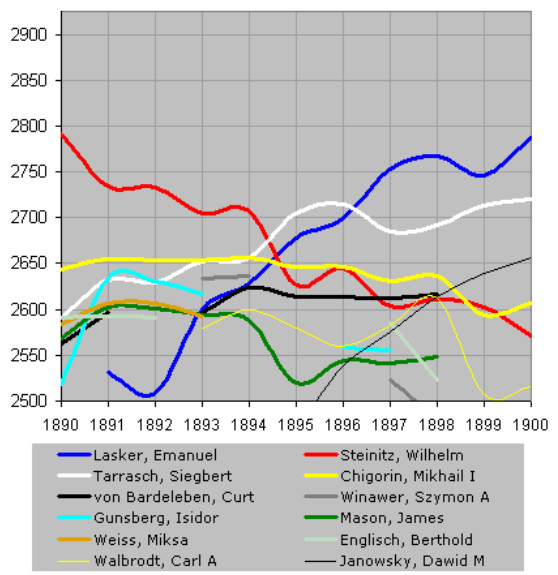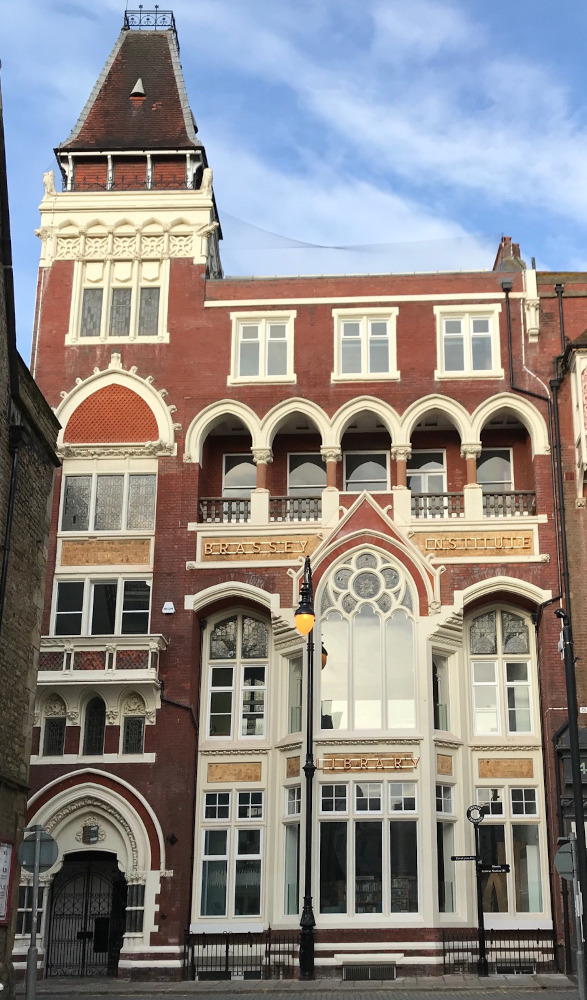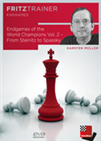A town that embraced chess
On October 14, 1066, William the Conqueror and his invading army defeated the forces of King Harold Godwinson in Hastings, England. William had crossed the English Channel from the duchy of Normandy, France, to claim what to him was the English throne promised by King Edward the Confessor, Harold’s predecessor. In victory, William would bring the Norman way of life to England and transform its social, cultural, and political landscape. Over hundreds of years, the country would evolve from its Anglo-Saxon beginnings to the England known today.
 The name Emanuel Lasker will always be linked with his incredible 27 years reign on the throne of world chess. In 1894, at the age of 25, he had already won the world title from Wilhelm Steinitz and his record number of years on the throne did not end till 1921 when Lasker had to accept the superiority of Jose Raul Capablanca. But not only had the only German world champion so far seen off all challengers for many years, he had also won the greatest tournaments of his age, sometimes with an enormous lead. The fascinating question is, how did he manage that?
The name Emanuel Lasker will always be linked with his incredible 27 years reign on the throne of world chess. In 1894, at the age of 25, he had already won the world title from Wilhelm Steinitz and his record number of years on the throne did not end till 1921 when Lasker had to accept the superiority of Jose Raul Capablanca. But not only had the only German world champion so far seen off all challengers for many years, he had also won the greatest tournaments of his age, sometimes with an enormous lead. The fascinating question is, how did he manage that?This is Hastings, the coastal town known primarily for the battle on an October day that became a major turning point in history. Anything else about it, perhaps, pales in significance, but it is worth noticing that this same town has come to embrace chess. The Hastings International Chess Congress held every turn of the year is not only a top-class event but a tradition of more than a century. It is the longest running tournament in the world.
One of the earliest editions of Hastings’ serial tournaments happens also to be the most famous. In 1882, residents of Hastings formed the Hastings and Leonards Chess Club, which grew by mid-1890. With its funds donated by wealthy residents and generous Englishmen, the club invited the days’ greatest names for the Hastings Summer Congress of 1895. More than eight hundred years after the battle between William and Harold, the tournament was a royal battle on its own. For its field and sheer beauty of the games produced, the event is now quite mythical.
Consider the ChessMetrics rating of 1895:

| # |
Player |
Rating |
+/- |
| 1 |
Tarrasch, Siegbert |
2714 |
56 |
| 2 |
Lasker, Emanuel |
2699 |
53 |
| 3 |
Chigorin, Mikhail I |
2647 |
54 |
| 4 |
Steinitz, Wilhelm |
2645 |
53 |
| 5 |
von Bardeleben, Curt |
2614 |
57 |
| 6 |
Pillsbury, Harry N |
2581 |
54 |
| 7 |
Teichmann, Richard |
2580 |
57 |
| 8 |
Walbrodt, Carl A |
2560 |
57 |
| 9 |
Gunsberg, Isidor |
2558 |
61 |
| 10 |
Blackburne, Joseph |
2549 |
56 |
Siegbert Tarrasch down to Joseph Henry Blackburne all participated, which means that the event had successfully gathered the top ten players of the world that year. Even by today’s modern standards, not every super-tournament can gather the world’s ten best players.
There was, of course, Emanuel Lasker, who was fresh from capturing the world title from Wilhelm Steinitz the previous year. Lasker rose to the world championship only five years after his first international appearance in 1889, and many saw him untested. He was looking to prove himself by taking Hastings 1895, the first super-tournament of his career.
There was also the deposed champion himself, Wilhelm Steinitz, who had been a top player since the 1860s. Although he was past his best and was nearing the end of his career, his fellow participants could not overlook his influence. Since working as a journalist in the 1870s, Steinitz had disseminated the principles of classical play by his books and writing, and chess had well moved from the Romantic to the Classical Age by 1895 largely because of him.
Mikhail Chigorin, the world championship contender of 1889 and 1892 and the last of the great Romantics, also came to play. So did Tarrasch, who was then a fearsome tournament player. He had won five international events from 1888 to 1894, and had passed up the chance to challenge Steinitz for the world title due to his medical practice. Isidor Gunsberg was another world title contender.
 Learn about one of the greatest geniuses in the history of chess! Paul Morphy's career (1837-1884) lasted only a few years and yet he managed to defeat the best chess players of his time.
Learn about one of the greatest geniuses in the history of chess! Paul Morphy's career (1837-1884) lasted only a few years and yet he managed to defeat the best chess players of his time.The remaining top ten participants, Curt von Bardeleben, Richard Teichmann, Carl August Walbrodt, Blackburne, and Harry Nelson Pillsbury hadn’t been title contenders, at least not yet, but they were very strong themselves. Pillsbury, in particular, was the dark horse. Not much had been known of him except that he had stirred American chess with impressive results, and had become quite a sensation there. The Brooklyn Chess Club sponsored his participation in Hastings for his first international appearance. Whether he could hold up against the vaunted European opposition remained to be seen.
The rest of the participants were either grizzled or rising masters eager to make their mark. Emanuel Schiffers, Amos Burn, James Mason, Henry Bird, Adolf Albin, George Marco, Samuel Tinsley, William Pollock, Jacques Mieses, and Benjamin Vergani were the veterans, past their thirties, some in their forties, and all experienced tournament players. David Janowski and Carl Schlechter, on the other hand, were the emerging stars of the new generation. Their best years were ahead of them, and they would eventually play title matches with Lasker themselves more than a decade later.
With a single-round robin format, the twenty-two participants played twenty-one rounds. Lots were drawn to determine the pairings from the first to the last round, but these were not revealed until the morning of each play day. Play was set at thirty moves for the first two hours, and fifteen moves for every succeeding hour. The tournament ran from August 5 to September 2, with the Brassey Institute, now the Hastings Public Library, as venue.

The Brassey Institute
The early rounds were a five-man race among Chigorin, Pillsbury, Lasker, Steinitz, and von Bardeleben. Chigorin scored eight victories in his first nine games to lead at 8 points. Pillsbury and von Bardeleben were right behind at 7.5 points. Lasker was a little further back at 7. Steinitz had led after five rounds, conceding only one draw, but four consecutive losses from rounds six to nine left him watching the pack pull away.
In round 10, Steinitz scored his famous brilliancy over von Bardeleben. The loss must have rattled Bardeleben, as he suffered more losses the rest of the way. That left only Chigorin, Pillsbury, and Lasker fighting for first place. They led jointly after seventeen rounds at 13.5 points.
Pillsbury lost to Schlechter in the following round, but misfortune struck Lasker when he lost to his rival Tarrasch and Blackburne in rounds nineteen and twenty. Chigorin was poised to take the tournament. A gut-wrenching loss to Janowski in round twenty, however, left him half a point behind Pillsbury going into the last round. Lasker was a further half point behind Chigorin.
In the final round, Chigorin took on Schlechter while Pillsbury faced Gunsberg. Pillsbury chose a quiet game, but, seeing Chigorin take the initiative against Schlechter, played for a win in an equal position. The result was a stunning Knight endgame, which all but sealed Pillsbury’s victory whatever was the result of Chigorin’s and Lasker’s games.
Thus, in a field that included two World Champions (Steinitz and Lasker), and what would come to be five world title contenders (Chigorin, Gunsberg, Tarrasch, Janowski, and Schlechter), it was the relatively unknown Pillsbury who won the tournament.
Hastings 1895 - Final standings
 Enjoy Capablanca's fine technique, Tal's magic, Lasker's fighting spirit, Petrosian's defensive skills, Smyslov's feeling for harmony, and Alekhine's and Spassky's flair for the attack.
Enjoy Capablanca's fine technique, Tal's magic, Lasker's fighting spirit, Petrosian's defensive skills, Smyslov's feeling for harmony, and Alekhine's and Spassky's flair for the attack.Hastings 1895 could have settled then the shaky top of the chess order, but it raised even more questions. Was Lasker really the strongest player? Was Chigorin deserving of a match against the new champion when he had lost his two previous world championship matches? Should Steinitz be granted the rematch he was seeking from Lasker as he was in the thick of the great tournament’s race? What of Tarrasch who defeated Lasker and relegated him to third place? Should Pillsbury, with his impressive talent, be given an immediate title shot?
Quite fittingly, the five players were invited to play among themselves later that year in the great St. Petersburg Tournament of 1895-96. Only a face off among them could settle the questions Hastings 1895 had provoked.
 For the moment, however, the chess world celebrated Pillsbury, and he basked in his spectacular success. Later he would recall the tournament, and spoke of the warm regard the players in Hastings gave each other, even in the heat of battle. He said:
For the moment, however, the chess world celebrated Pillsbury, and he basked in his spectacular success. Later he would recall the tournament, and spoke of the warm regard the players in Hastings gave each other, even in the heat of battle. He said:
The reception to me at Hastings was very cordial, especially on the part of Steinitz, Tarrasch, and Chigorin. The English players, Blackburne and Bird, were also very courteous. Before the tournament began, we would sit for hours and discuss matters pertaining to chess, or analyze a game, or try to expand the theories of certain openings, and so on, and I shall not forget the many happy and pleasant hours I spent with these gentlemen at Hastings. The same feeling was shown to me after defeating Gunsberg in the final round. When it was known that I had won the game, Chigorin, Steinitz, and Tarrasch left their respective boards on which they were engaged to play and came over to congratulate me on my success, saying many nice things to me.
Thus did Hastings 1895 introduce Pillsbury to elite chess. He would become one of the most brilliant players at the turn of the 20th century, and a leading candidate to challenge Lasker. If only remotely, or figuratively, his dramatic race to the finish with Chigorin and Lasker hearkened back to the old battle of 1066, for it made Hastings once again the vast ground of a grand battle.
Games
The following notable games are presented in the dynamic replayer below. To switch between games, select an entry from the list.
- Steinitz vs. von Bardeleben (Round 10) – Steinitz’s magnum opus has become very familiar, but no Hastings 1895 games collection is ever complete without it.
- Pillsbury vs. Gunsberg (Round 21) – The game Pillsbury had to win to ensure first place, and one of the most beautiful endgames ever played. It combines the theme of the protected passed pawn with flawless calculation.
- Albin vs. Bird (Round 1) – Famous for his opening 1. f4, Bird plays the Dutch Defense and catches Albin in an intuitive, sacrificial attack.
- Janowski vs. Steinitz (Round 17) – Janowski at his best. Steinitz misplays the opening and lags in development. His punishment is quick, and fatal.
- Tarrasch vs. Janowski (Round 18) – Tarrasch, demonstrates the correct treatment of an isolated pawn position. He plays dynamically and makes short work of Janowski. The tactics, against a master tactician himself, are very impressive.
Links




















 For the moment, however, the chess world celebrated Pillsbury, and he basked in his spectacular success. Later he would recall the tournament, and spoke of the warm regard the players in Hastings gave each other, even in the heat of battle. He said:
For the moment, however, the chess world celebrated Pillsbury, and he basked in his spectacular success. Later he would recall the tournament, and spoke of the warm regard the players in Hastings gave each other, even in the heat of battle. He said:




